This sensational pho recipe is restaurant-quality and easier and quicker to make than you think!
This pho soup recipe will have you slurping a big bowl of steaming hot pho in less than 60 minutes! The easy broth is bursting with beefy, earthy, complex yet delicate flavors laced with quintessential cinnamon, star anise, cloves and cardamom. I’ve shortcut the long simmering processes by using quality beef bone broth then adding charred onions and ginger and toasted spices, then simmering for just 45 minutes while you prep the garnishes. To your rich, savory pho broth, you can add beef, chicken, pork or shrimp along with your chewy rice noodles, a handful of fresh herbs and a splash of lime juice, hoisin and sriracha. This pho recipe also earns major points because it can be prepped ahead or frozen and then just warmed when ready, so you can sit back and enjoy pho in your slippers just the way you like it!
If you love Asian inspired soups with their aromatic broths and layers of flavors, you’ll love Thai Chicken Noodle Soup, Egg Drop Soup, Tom Kha Gai, Miso Soup with Chicken and Noodles, Laksa (Thai Coconut Soup) and Hot and Sour Soup.

PIN THIS RECIPE TO SAVE FOR LATER
Homemade Pho Noodle Soup
Are you obsessed with pho like me? If you’re not, you will be! Pho warms you up without weighing you down, is layered with subtle, warm, earthy, gingery, garlicy, beefy broth, crunchy, chewy, melt-in-your mouth textures and splashes of bright, fresh, herbalicious garnishes. In short, every slurpful is a cozy, complex, aromatic symphony. And the best part is, it’s perfectly customizable! You can use beef, chicken pork or shrimp and everyone can load on their favorite toppings making it a super fun meal for entertaining – or just because.
It took me a while to tackle this pho recipe because I assumed making pho at home required exotic ingredients and simmering a pot of bones and veggies all day. But it turns out, making pho at home can be EASY and EXTRAORDINARY.
To me, pho is only as good as its broth. Traditional pho is made by simmering bones, oxtail and flank all day along with veggies and a cozy blend of spices. I discovered I could shortcut this process at home by starting with quality bone broth – broth that has already been simmered for 20+ hours – or in other words, all the work is already done for you!
Now, all we have to do is add charred onions and ginger which infuse the broth with its signature charred smokiness (and take less than 5 minutes to char) and toasted spices. In pho, cinnamon and star anise take center stage, with support from cloves, coriander and cardamom. As the ingredients simmer together, the pho broth transforms into restaurant quality that tastes like it’s been simmering for hours. You will be amazed at the flavor coming out of your kitchen!
While your broth is simmering, you prep your garnishes and cook the noodles so all that’s left is for everyone to garnish their own bowls just the way the like them – all that in 60 minutes. Who’s ready to pho?!
I’m going to go into detail about this pho recipe: pho ingredients, how to make pho, tips and trick, etc. so you can read on or use the “jump to recipe button” at the top of the page to skip directly to the recipe.
What is Pho?
Pho (pronounced “fuh”), is a popular Vietnamese noodle soup and is considered Vietnam’s national dish. It is made with a rich, spiced beef broth, rice noodles, thinly sliced meat, and toppings galore such has bean sprouts, cilantro, mint, Thai basil, green onions, hoisin and sriracha. The bone broth usually simmers for up to a day but in this shortcut version, you’ll be slurping your pho in an hour!
Something unique about pho is how it’s assembled. Cooked rice noodles are first added to the serving bowl, followed by uncooked, thinly shaved beef. The hot broth is then poured over the noodles and cooks the beef on contact. The plethora of toppings are then piled onto the soup, (easily customized by the eater!) then slurped up to create the ultimate textural experience.
Homemade Pho Ingredients
This isn’t a from scratch pho recipe, but this shortcut version is PACKED with flavor in a fraction of the time that traditional pho takes to make. Here’s what makes this fabulous pho recipe work:
THE PROTEIN
Pho is most commonly made with beef but may use whatever protein you desire. If using steak, chicken or pork, you will need to slice them razor thin in order for the protein to cook in the broth upon contact.
To accomplish this, ask your butcher to do it for you – as thin as possible! – or pop the steak, chicken or pork into the freezer for about 60 minutes, until it’s solid and won’t slide beneath your knife. Slice the protein as thinly as possible. If adding raw protein to your pho scares you, you can always use pre-cooked meat or add it to the big pot of broth for a few seconds before dishing up.
Here are the protein options:
- Steak: I recommend beef tenderloin because it’s the most tender cut of beef, which is what you want and need for a steak that cooks by hot broth alone. Beef tenderloin is expensive but you only need 8 ounces of it, so it doesn’t ring up too pricey. Since you only need 8 ounces, go for fillet mignon if you can, which is the most tender cut of the entire beef tenderloin.
- Chicken: I recommend chicken thighs because they are much juicer and more flavorful.
- Pork: I recommend pork tenderloin for pho because as its name implies, it is tender! It also has hardly any excess fat so it doesn’t become chewy.
- Shrimp: use raw, peeled, deveined shrimp with the tail removed.

THE BROTH
- Beef bone broth: The broth makes the pho so please go for gold! You want to use a quality beef bone broth (may sub beef stock in a pinch). Bone broth is essentially stock, made with meaty bones, vegetables, herbs, seasonings and aromatics but is slow simmered for longer, than beef broth, for 20+ hours. This results in deeper, more flavorful broth. See my detailed recommendations below.
- Beef bouillon: Is made from dehydrated vegetables, meat stock, a small portion of fat, salt, and seasonings AKA it’s salt with flavor! You can use bouillon powder, bouillon cubes or better than bouillon. Add it to the soup without dissolving in liquid first. If using cubes, crush up and then add directly to the broth then stir to dissolve.
- Onion: Is caramelized in a cast iron skillet first to add a hint of smokiness to the entire broth.
- Ginger: Is caramelized with the onions. It adds a warm and spicy, almost peppery taste to the pho soup.
- Fish sauce: I promise fish sauce will not be detectable or make your pho recipe taste fishy! It simply adds the balance of savory and salty flavor. I recommend Red Boat Fish Sauce 40°N. Fish sauce adds more complexity than soy sauce but you may substitute fish sauce with soy sauce in a pinch.
- Sugar: Adds sweetness to balance the fish sauce and salty broth. You may need more or less sugar depending on personal preferences.
- Spices: The pho soup is flavored with star anise, whole cloves, whole coriander seeds cardamom pods, and cinnamon sticks. These spices cannot be skipped! They add a wonderful depth of complexity and is what makes pho taste so unique!
- Rice noodles: Are very thin rice noodles, sometimes called rice sticks or rice vermicelli. Rice noodles need to be cooked according to package instructions, rinsed, drained and tossed in a splash of oil to prevent them from clumping. The rice noodles are one of my favorite noodles to use as they are made from rice flour and maintain their perfectly al dente texture for days, if not overcooked initially, making the soup perfect leftovers! You should be able to find rice noodles in the Asian section of your grocery store.
Where can I buy the spices?
These are probably spices that you don’t keep stocked and won’t need a whole jar of. You can pick up a la carte spices at the bulk bins at Sprouts or WinCo.
What Beef bone Broth is best?
As previously discussed, you will want quality beef bone broth. Here are my top picks:
- 1. Kettle and Fire: is beefy, savory, with roasted, caramel notes and aromatic veggies. It can be found on Amazon, Sprouts (shelf stable/not frozen) or use their store locator.
- 2. Bonafide Beef Bone Broth: is beefy, savory, and smooth. It is frozen fresh, so look for it in the frozen aisle of Whole Foods, Walmart, or use the store locator.
- 3. Bare Bones Broth: is beefy but thinner and more subtle. It can be found at Whole Foods (shelf stable/not frozen), Amazon or use the store locator.

Pho TOPPINGS
Pho soup itself is very simple but is meant to be dressed up with loads of toppings. This allows everyone to customize their own pho just how they like it. The fresh herbs brighten the rich beefy soup and are a signature of Vietnamese food, the veggies add the texture and freshness, and the condiments (hoisin sauce, Sriracha, soy sauce and fish sauce) bring the flavor and heat. You can load your pho with all of the toppings and condiments or pick your favs but I recommend at least two herbs and one condiment:
- Fresh herbs: Cilantro, Thai/Vietnamese basil and or/mint are a must! They really brighten up the soup and add a pop of fresh flavor that pairs so nicely with the rich broth and hearty beef. You will want at least two fresh herbs. Thai basil is similar to our standard Italian basil with a subtle aniseed flavor, usually only found at Asian markets. If you can’t find it, you may use traditional basil.
- Green onions: Add a mild onion flavor. Slice thinly so they become evenly distributed in the soup.
- Bean sprouts: You can’t have pho without bean sprouts! Bean sprouts are found in the refrigerated produce section of the grocery store. They have a short shelf life, so plan accordingly.
- Radishes: Add a kick of spicy, peppery, zesty crunch.
- Lime: Awakens the entire soup. Add more or less to taste.
- Hoisin: Tastes like a sweet, salty and tangy, thick Asian BBQ Sauce. It can be found in the Asian section of any grocery store. Please use only quality hoisin sauce like Lee Kum Kee or Kikkoman as all hoisin sauces are not created equal – you truly can taste the difference. I use hoisin sauce all the time in my Asian recipes such as Kung Pao Shrimp, Mongolian Chicken, Orange Chicken, etc., so I promise it will not go to waste!
- Chili sauce: If your pho soup is missing something, it is heat! Add chili sauce (like Sriracha) to taste. If you aren’t sure how much to add, you can start with less then always add more.
- Chilies: Sliced Thai bird chiles, jalapeños, serrano peppers, or Fresno peppers are another way to add some heat to the pho soup. Leave some of the seeds in if you love heat.
How to Make Pho Soup
Pho may seem out of your comfort zone, but it’s actually one of the easiest soups to make with this shortcut broth! It’s as easy as adding onions to a skillet, broth ingredients to a pot, boiling some noodles, and adding toppings. Here’s how to make pho with step-by-step instructions:
- Step 1: Freeze protein. Place the steak, pork or chicken in the freezer so it is partially frozen by the time you’re ready to use it. Slicing partially frozen meat is much easier to get razor thin.
- Step 2: Make the broth. Char the onions and ginger in a cast iron skillet for just 3 minutes or so while you toast the spices in a large Dutch oven. Add the charred onions, ginger, and beef broth to the Dutch oven and simmer for 45 minutes, then strain the broth and return it to pot. Stir in fish sauce, brown sugar and beef bouillon to taste.


- Step 3: Cook the noodles. While the broth is simmering, prepare the garnishes and cook the rice noodles according to package directions. Drain the noodles, rinse in cold water and toss with a drizzle of sesame oil (to prevent the noodles from sticking together); set aside.
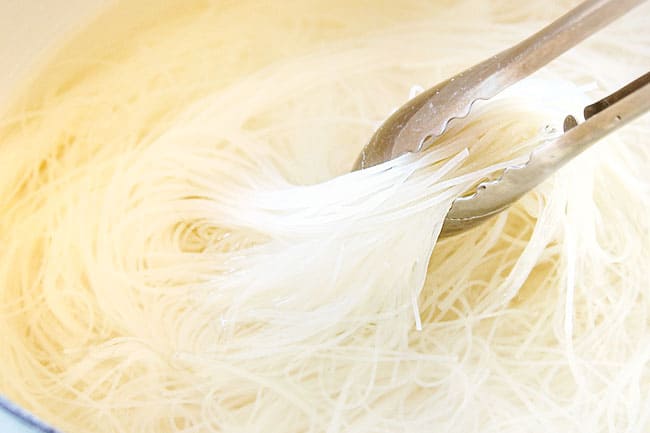
- Step 4: How to serve pho. Divide noodles and thinly sliced steak, chicken or pork between 4 bowls. Bring the broth back to a simmer so it’s piping hot and will cook the protein. Ladle the hot broth over the protein so it is completely submerged in order to cook. Top each bowl with desired garnishes and dig in (a more detailed look below).

Can I Prepare Pho in Advance?
You should wait to assemble the bowls of pho until you’re ready to eat them, but you can certainly prepare the individual components ahead of time:
- Broth: Make the broth, strain it, and store it covered in the refrigerator for up to one week or freeze for up to three months.
- Toppings: Prepare the toppings then store in individual containers in the fridge for up to three days.
- Rice noodles: Take almost no time to cook, so I recommend making them day of. However, if you want to cook them in advance take extra care not to overcook your noodles, drain, then toss with a drizzle of sesame oil to prevent them from sticking together; store in an airtight container in the refrigerator.
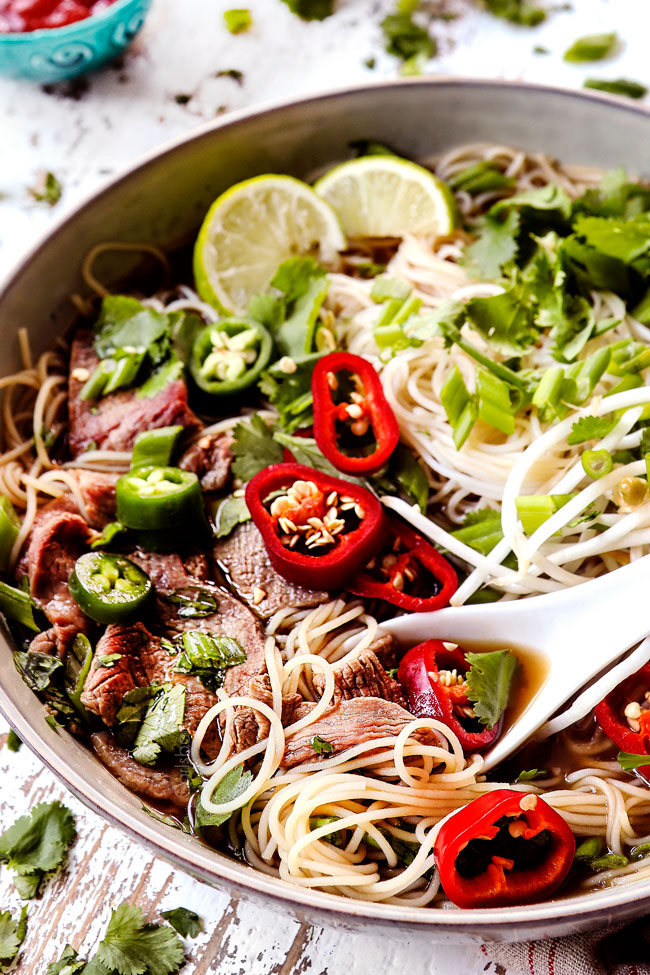
How to eat Pho
The beauty about homemade pho is you can eat it any way you wish! Here’s how to eat it the traditional Vietnamese way:
- Add toppings: The hot steaming bowl of pho is traditionally accompanied by a plate of fresh toppings such as Thai basil, cilantro, mint, bean sprouts, chili slices, and lime. You’ll want to add a generous amount of each, then continue to add more as needed throughout eating.
- The condiments. The bowl of pho will also be accompanied by several condiments such as hoisin sauce, soy sauce, fish sauce, Sriracha, and chili paste. The soy sauce and fish sauce are used to flavor the broth and the hoisin sauce and chili sauce are used to flavor the meat and as such, should be placed directly on the meat not in the broth. In fact, at Vietnamese restaurants, side dishes are often provided for the hoisin and sriracha so you can dunk your steak directly in the sauce.
- Chopsticks, spoon, repeat. Generally, the chopsticks are held with the dominant hand and the spoon with the other. Refrain from leaving your chopsticks in your pho soup when not eating, doing so is considered rude. First, slurp the broth with a spoon, or it’s perfectly acceptable to stick your face into the bowl. Next, use chopsticks to swirl the perfect bite of noodles, bean sprouts and steak, devour, then follow with a slurp of broth. Repeat until the noodles are gone, then raise the bowl to your lips and drink up every last drop of precious broth.
Pho Soup Recipe Tips
Homemade pho is pretty straightforward, but here is a summary of tips and tricks to make life easier and your pho more delicious:
- Use quality beef bone-broth: Kettle and Fire and Bonafide are my top recommendations. Do you have a favorite?
- Season with beef bouillon: Really amps up the flavor, even if you have used a less quality broth. Wait until the soup has simmered for the full 45 minutes before deciding how much beef bouillon you would like to add. You will need more or less depending on what broth you use and personal preference. That being said, you want the broth slightly on the salty side because the saltiness will dilute when combined with the noodles, beef and toppings.
- Use rice noodles: The thin, chewy rice noodles really make the pho! Angel hair pasta or another thin noodle won’t deliver the same texture.
- Use whole spices: I don’t recommend powders for this pho recipe. You can pick up whole spices a la carte at the bulk bins at Sprouts or WinCo.
- Slice protein thinly: Otherwise, it won’t cook in the broth! I recommend asking your butcher to shave it for you, otherwise, freeze for 60 minutes before slicing as thinly as possible with a very sharp knife.
- Char onions well: You want the cut side of your onions to be very charred, burnt looking, for the deepest possible flavor.
- Use cast iron: A cast iron skillet is the best for charring the onions and garlic – NOT enamel cast iron. Charring will leave a residue that will need to be scraped off, which can ruin many finishes except cast iron.
- Don’t over-simmer the broth: Don’t simmer the broth longer than 45 minutes otherwise it will taste too strongly of cinnamon and star anise.
- Strain the stock: Make sure to strain the stock before assembling the bowls of soup. You can do this with a mesh sieve or a fine colander.
- Prepare noodles right before serving: Aim to start boiling the water for the noodles after the stock has been simmering for 25 minutes, this way your noodles stay fresh.
- Dunk raw meat if desired: If you can’t wrap your head around adding raw protein to the serving bowls, you can add it to the hot broth and let it partially cook before adding it to the serving bowls.
- Resist the urge to sauce your pho: The hoisin and sriracha should be reserved for the meat and not squeezed directly into the broth.
- Add extra lime juice to leftovers: The flavors of this pho soup tends to mellow out over time. I recommend adding a squeeze of lime juice to leftovers to brighten it up.

Pho Soup Variations to Try
There are so many different ways to make pho soup! Every element of it can be customized to fit your tastes.
- Homemade beef stock: I used a shortcut store-bought bone beef broth for this pho recipe, but you are welcome to make a homemade bone broth if you have time for it.
- Use leftover protein: You can use practically any leftover sliced or chopped protein in this pho recipe. Simply add leftover rotisserie chicken, steak, pork, etc. directly to the bowl then pour the hot both over to warm it instead of cook it.
- Swap the meat for tofu: Place firm tofu in a pie plate, top with a heavy plate and weigh down with 2 heavy cans (to release water). Set aside for 10 minutes, then chop into ½-inch cubes. You can add them to the serving bowls as is or sauté them to make them crispy before adding.
- Add more veggies: Traditional bean sprouts are just a start in the veggie department. You can use any quick cooking vegetables such as bok choy, shredded cabbage, mushrooms, bell peppers, zucchini, edamame, snow peas, etc.
- Low carb: swap the rice noodles for zoodles.
- Make it spicy: Add red pepper flakes directly to the broth. When adding toppings, you can also add more chili slices; keep the seeds in for a kick of heat!
Can I cook pho recipe in the crockpot?
Yes! You will still want to char the onions and ginger and toast the spices then add all of the broth ingredients to your slow cooker. Cook on high for 3 hours or on low for 6 hours. Strain the broth and add the fish sauce and sugar as directed.
What to Serve with Pho?
You can keep your pho dinner as simple or elaborate as you’d like. Serve it with a green side salad, or go all out with the Asian-inspired sides. Most of the sides and appetizers listed below are not Vietnamese, but all would pair nicely with this pho soup:
- Vietnamese Spring Rolls
- Cream Cheese Wontons
- Crunchy Asian Salad
- Crab Rangoon
- Pork Egg Rolls, Sesame Chicken Egg Rolls, Sweet and Sour Chicken Egg Rolls
- Chinese Chicken Wings or Korean Chicken Wings
- Potstickers
How Long Does Pho Soup Last?
Once the bowls of pho are assembled, they’re best enjoyed right away. The broth itself will last up to 5 days in the fridge. If possible, store the pho broth, toppings, and rice noodles separately for best results.
How to Reheat Pho Soup
- Stove: You can reheat large batches of pho on the stove over medium heat, stirring occasionally until hot. You will want the broth hot enough so it will cook raw protein if using.
- Microwave: For smaller batches or individual servings, you can use the microwave. Transfer soup to a microwave-safe dish, cover with a microwave-safe lid or paper towel. Microwave for 90 seconds, stir, then continue to microwave for 30-second intervals, if needed. You will want the broth hot enough so it will cook raw protein if using.
Can I Freeze Pho?
Once assembled, I don’t recommend freezing the pho soup. All of those raw veggies and fresh herbs wouldn’t freeze well. However, you can prepare a big batch of the broth, let it cool, then freeze for up to 3 months. Then, all you have to do is thaw the stock and reheat it to make pho soup whenever the craving hits!
Vietnamese Noodle Soup FAQs
Here are a few more random, interesting facts about pho!
Don’t let the spelling fool you, the ‘o’ is pronounced like “uh,” so the correct pronunciation is “fuh,” not “faux”.
The term pho actually refers to the white rice flour noodles that’s traditionally used in this soup, but when people refer to pho nowadays, they’re typically discussing the Vietnamese Noodle Soup as a whole.
It is believed that the word “pho” comes from the French word “feu,” meaning fire, and could possibly be a Vietnamese take on the French dish pot au feu which means, “pot on fire.”
It is believed that pho originated in the late 1880s in North Vietnam after the French colonization of the country. Pho is the result of both strong French and Chinese influences: rice noodle and spices imported from China, and the French popularization and cooking technique of red meat. After Vietnam was divided into north and south, many people moved to South Vietnam to escape the communist rule of the North, bringing pho with them. As the dish moved southward, it transformed from very simple pho served with chilies and lime only without bean sprouts or fresh herbs into pho nam, the popular version served at Vietnamese restaurants and what I am sharing with you today, seasoned with many spices, heavily garnished with fresh herbs and served with bean sprouts.
Pho is pretty healthy as is or can be made healthier by using chicken instead of beef and either brown rice noodles or zoodles.
Yes, this pho soup is gluten-free because the broth contains fish sauce and not soy sauce and the rice noodles are made of rice flour and water, and occasionally small amounts of tapioca or cornstarch as well. This means they are gluten-free, fat free, and vegan. Of course, you’ll want to double check the labels of your garnishes such has the hoisin and fish sauce to make sure they are certified GF.
The meat in pho is added to the bowl raw but is cooked by the boiling hot broth. In order for the meat to cook, it needs to be sliced paper thinly, the broth needs to be boiling hot and the protein needs to be completely submerged in the broth.
Yes, a beef bone broth is the most common broth used for pho, even when the pho doesn’t contain any protein. Beef broth is even used in Phở Mực (squid pho). The only time another broth is used is for Phở Gà (chicken pho), which uses chicken broth, Phở heo (pork pho) which uses pork broth and Phở Cá (fish pho) which uses fish broth.
Looking for More Asian Soup Recipes?
- Egg Drop Soup
- Wonton Soup
- Tom Kha Gai
- Thai Chicken Noodle Soup
- Miso Soup with Chicken and Noodles
- Laksa (Thai Coconut Soup)
- Curried Butternut Squash Soup
- Thai Soup with Chicken and Wild Rice
- Hot and Sour Soup

Want to try this Pho RECIPE?
Pin it to your Dinner, Asian or Soup Board to SAVE for later!
Find me on Pinterest for more great recipes! I am always pinning :)!
©Carlsbad Cravings by CarlsbadCravings.com

Pho Noodle Soup
Save This Recipe To Your Recipe Box
You can now create an account on our site and save your favorite recipes all in one place!
Ingredients
Broth
- 1 large white onion peeled and halved
- 2 3-inch pieces of fresh ginger halved lengthwise
- 5 whole star anise
- 4 whole cloves
- 4 cinnamon sticks
- 3 cardamom pods
- 1 1/2 tablespoons whole coriander seeds
- 1/2 tablespoon fennel seeds optional
- 8 cups quality beef bone broth see recommendations in notes
Add later
- 1 tablespoon fish sauce
- 1 tablespoon brown sugar
- 1 tablespoon beef bouillon or better than bouillon more or less to taste
Assembly
- 6-8 ounces rice stick noodles
- 8 ounces beef tenderloin (fillet mignon) shaved paper thin (see notes for protein options)
Toppings
- sliced green onions
- cilantro, mint, and/or Thai basil
- bean sprouts
- sliced chilies Thai bird chiles, serrano, Fresno or jalapenos
- sliced radishes
- lime wedges
- sriracha
- hoisin
Instructions
- Place the steak, pork or chicken in the freezer so it is partially frozen by the time you’re ready to use it, 45-60 minutes in the freezer is ideal. Slicing partially frozen meat is much easier to get razor thin.
- Heat a cast iron skillet over high heat. Once smoking, place onion and ginger in pan cut side down. Cook for about 3 minutes until onions are charred, then flip onions over (don’t flip ginger). Cook another minute then remove pan from heat.
- Heat a large Dutch oven/stockpot over medium high heat. Add star anise, cloves, cinnamon, cardamom, fennel and coriander and toast for 3 minutes. Add the charred onions, ginger and beef broth. Stir to separate the onions somewhat. Cover the pot to bring to a simmer, then reduce to low and simmer for 45 minutes (no more).
- While the broth is simmering, prepare garnishes. Cook the rice noodles according to package directions. Drain the noodles, rinse in cold water and toss with a drizzle of sesame oil (to prevent the noodles from sticking together); set aside.
- After 45 minutes, strain the broth and return it to the pot. Stir in fish sauce and brown sugar. Taste and add beef bouillon or better than bouillon to taste. Adjust other seasonings if desired.
- To assemble, divide noodles and beef between 4 bowls. Bring the broth back to a simmer so it’s piping hot and will cook the protein. Ladle the hot broth over the steak so it is completely submerged in order for it to cook. Let everyone top their bowls with desired garnishes – the more the better!
Notes
Protein options:
Pho is most commonly made with beef but may use whatever protein you desire. If using steak, chicken or pork, you will need to slice them razor thin in order for the protein to cook in the broth upon contact.- Steak: I recommend beef tenderloin because it’s the most tender cut of beef, which is what you want and need for a steak that cooks by hot broth alone. Because you only need 8 ounces, go for fillet mignon if you can, which is the most tender cut of the entire beef tenderloin.
- Chicken: I recommend chicken thighs because they are much juicer and more flavorful.
- Pork: I recommend pork tenderloin for pho because as its name implies, it is tender! It also has hardly any excess fat so it doesn’t become chewy.
- Shrimp: use raw, peeled, deveined shrimp with the tail removed.
Tips for Making Pho Recipe
Homemade pho is pretty straightforward, but here is a summary of tips and tricks to make life easier and your pho more delicious:- Quality beef bone-broth makes the soup! Kettle and Fire (found on Amazon, Sprouts (shelf stable/not frozen) or use their store locator) or Bonafide Beef Bone Broth (found frozen at Whole Foods, Walmart, or use the store locator) are my top picks.
- Rice noodles: Are very thin rice noodles, sometimes called rice sticks or rice vermicelli. They should be easy to find in the Asian section of your grocery store. You may use wider rice noodles if you prefer. Angel hair pasta or another thin noodle won’t deliver the same texture.
- Season with beef bouillon: Really amps up the flavor, even if you have used a less quality broth. You can use bouillon powder, bouillon cubes or better than bouillon. Wait until the soup has simmered for the full 45 minutes before deciding how much beef bouillon you would like to add. You will need more or less depending on what broth you use and personal preference. That being said, you want the broth slightly on the salty side because the saltiness will dilute when combined with the noodles, beef and toppings.
- Where to purchase whole spices: I don’t recommend powders for this pho recipe. You can pick up whole spices a la carte at the bulk bins at Sprouts or WinCo or order them online by clicking on the ingredient: star anise, whole cloves, whole coriander seeds cardamon pods, and cinnamon sticks.
- Slice protein thinly: Otherwise, it won’t cook in the broth! I recommend asking your butcher to shave it for you, otherwise, freeze for 45-60 minutes before slicing as thinly as possible with a very sharp knife.
- Char onions well: You want the cut side of your onions to be very charred, burnt looking, for the deepest possible flavor.
- Don’t over-simmer the broth: Don’t simmer the broth longer than 45 minutes otherwise it will taste too strongly of cinnamon and star anise.
- Dunk raw meat if desired: If you can’t wrap your head around adding raw protein to the serving bowls, you can add it to the hot broth and let it partially cook before adding it to the serving bowls.
- Resist the urge to sauce your pho: The hoisin and sriracha should be reserved for the meat and not squeezed directly into the broth. In fact, at Vietnamese restaurants, side dishes are often provided for the hoisin and sriracha so you can dunk your steak directly in the sauce.
How to Store and Reheat
- Storage: Once the bowls of pho are assembled, they’re best enjoyed right away. The broth itself will last up to 5 days in the fridge. If possible, store the pho broth, toppings, and rice noodles separately for best results.
- Freeze: You can freeze the broth without the meat or toppings for up to three months. Thaw before reheating.
- Stove: Reheat large batches of pho on the stove over medium heat, stirring occasionally until hot. You will want the broth hot enough so it will cook raw protein if using.
- Microwave: Transfer soup to a microwave-safe dish, cover with a microwave-safe lid or paper towel. Microwave for 90 seconds, stir, then continue to microwave for 30-second intervals, if needed. You will want the broth hot enough so it will cook raw protein if using.
Make Ahead
You should wait to assemble the bowls of pho until you’re ready to eat them, but you can prepare the individual components ahead of time:- Broth: Make the broth, strain it, and store it covered in the refrigerator for up to one week or freeze for up to three months.
- Toppings: Prepare the toppings then store in individual containers in the fridge for up to three days.
- Rice noodles: Take extra care not to overcook your noodles, drain, then toss with a drizzle of sesame oil to prevent them from sticking together; store in an airtight container in the refrigerator.

Did You Make This Recipe?
Tag @CarlsbadCravings and Use #CarlsbadCravngs
Leave a Review, I Always Love Hearing From You!
Carlsbad Cravings© Original








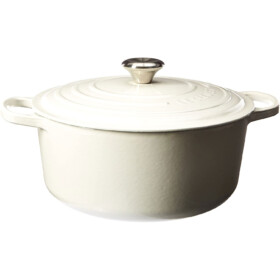
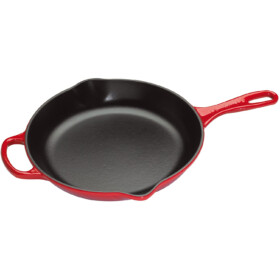
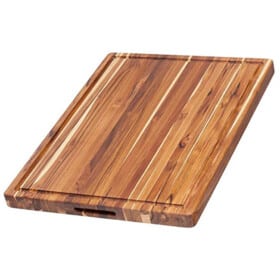
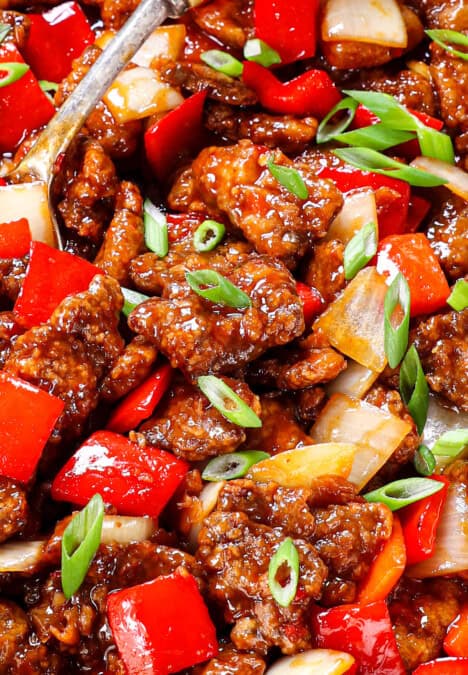







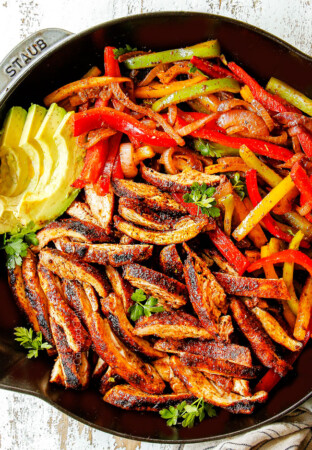

















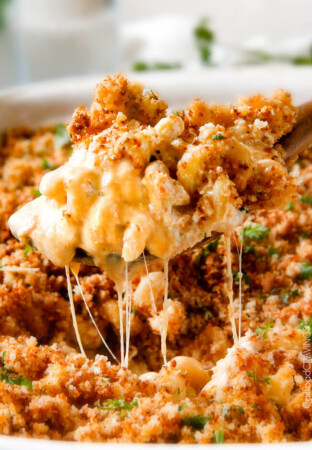


Olivia says
Of the Lee Kum Kee Hoisin Sauce which flavor do you use?
Jen says
Hi Olivia, I use their standard hoisin sauce, it just sauce “hoisin sauce” on the label.
Nathan Seamist says
I Am a die hard Pho fan… Your Pho Looks Delicious… Nathan
Jen says
Thanks Nathan, I’m excited for you to try it!
Trish says
WOW!!! This was amazingly easy and so very delicious! Yes, I’m using lots of exclamation points but I can’t help it!! I made the chicken version. I am definitely making this again, and soon!!
Jen says
I love all exclamation points, thank so much Trish! I’m thrilled it is a new repeat favorite!
Katie says
I just wanted to say that your website is my go to for our weekly menus! Absolutely love all your recipes and this Pho recipe was so good! My 6 year old who doesn’t eat anything that isn’t out of the microwave even yelled “Mom I love this.!” I do have a question though, above when you are describing the ingredients you say to char the onion and garlic but the recipe and picture it’s ginger.
Jen says
Thanks so much Katie, I’m honored you’re loving my recipes and that this pho was another winner! Thanks for pointing out the garlic, it should definitely read ginger – fixing now!
Jakalyn says
Hello Jen, I made this today and oh my, it’s wonderful! I was a little leery – a bit out of my normal comfort zone you know? But my daughter made it and said Mom you’ve got to try it! So I followed your directions exactly, sliced the tenderloin very thin, added all the toppings. My husband loved it. Thank you again for another wonderful recipe.
Best, Jakalyn
Jen says
Thank you for taking the time to comment Jakalyn! I love that you stepped out of your comfort zone and I’m so pleased the results were worth it! Bravo!
Cindy says
Ugh
How about cutting back on sponsors? I could barely read the recipe between ads and gave up.
Jen says
Aw, the price of free recipes… You can always use the “jump to recipe button” at the top of the post and skip right to the recipe.
Erica says
When doubling the recipe, do I double everything? Look forward to trying this!
Jen says
Yes, everything should be doubled! Hope you enjoy!